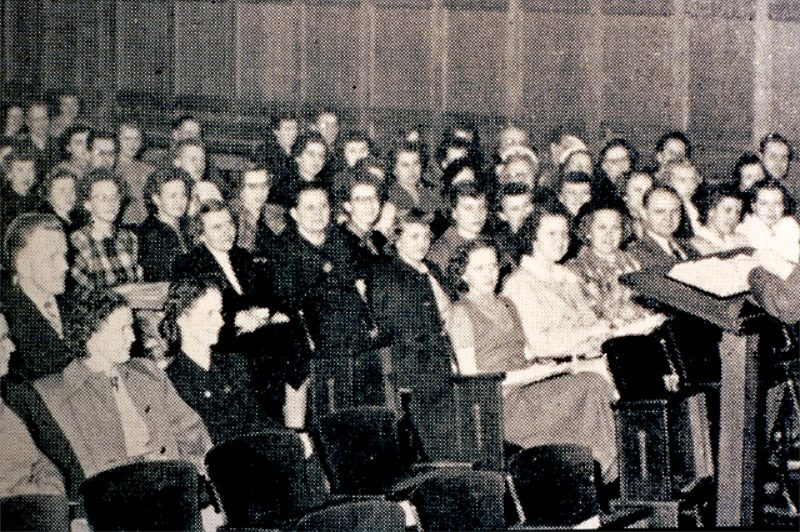In 1937 the South American Mission Prayer League organized formally in Minneapolis. By the end of the year, the organization had sent its first missionaries – John Carlsen and Ernest Weinhardt, off to the mountains of Bolivia. In 2012 we celebrate the 75th anniversary of their sending!

This is a story with important antecedents. It is based, in particular, in a strategic understanding of the frontiers of God’s mission in the world.
Some years before, in 1910, missionary leaders from around the world gathered in Edinburgh to evaluate the status of world evangelization, formulate some goals, and project their way into a new century. This was the Edinburgh World Missionary Conference.But Latin America was excluded from consideration.
Conference organizers wanted participation by the Church of England – an obvious consideration in a city like Edinburgh. But the Church of England considered South America a Christian continent, and not a suitable target for world evangelization. If the Anglicans were to participate, they insisted, Latin America must be removed from the agenda. Kenneth Scott Latourette points out that “many from the United States were unhappy over the omission.” (1)
“In order to correct what they believed to be the mistaken impression given by the Edinburgh World Missionary Conference, Protestants held evangelical congresses in Panama in 1916, in Montevideo, Uruguay in 1925 and Havana, Cuba in 1929. These congresses legitimized missionary efforts in Latin America and stimulated new initiatives in mission.” (2) The conferences described vast tracts of “unoccupied fields” – notably Bolivia, Ecuador and Peru – and “inadequately occupied fields” elsewhere in the continent. (3) Organizers concluded that “South America has come to the psychological and providential moment for Christian evangelization.” (4)
This was the backdrop for a “missionary survey” course at the Lutheran Bible Institute of Minneapolis, taught by Clarence Granlund in the fall of 1932. South America was widely considered “the neglected continent” – language that dates to Edinburgh itself. (5) Evald Conrad, then pastor of Trinity Lutheran Church of Minnehaha Falls and one of our earliest leaders, certainly reflects this estimation. “[South America] indeed is the neglected continent,” Conrad reported. “We have forgotten our neighbor.” (6)
Granlund’s survey presented a compelling case for missionary outreach in South America – and made a deep impression on John Carlsen, then a student at the Bible Institute. “While the teacher moved on to other areas in his survey,” reported fellow student Stanley Olson, “most of us remained with our thoughts and prayers riveted on South America.” (7)
This was the beginning of the Prayer League. Already in 1932, Carlsen, Olson – and very soon Weinhardt, too – met every Thursday evening to pray for the “neglected continent.” They prayed for months and years. In 1937, Olson reported, “we finally realized that there must be answers to our prayers, and that missions included more than prayer – it also meant obedience to the commission to go.” (8) In May of that year they were organized. And by the end of the year they were off.
As we look back, now 75 years later, it is easy to see the pattern: God was doing something on a very large scale, mobilizing broadly for the sake of his broad purposes in the world. God was doing something much bigger than Weinhardt, Carlsen and the Prayer League. He was enlisting his people for the sake of his cause. He was illuminating then-neglected frontiers, engaging unbelief, moving and equipping his people, and sending them as gospel ambassadors into the world.
Luther had this dynamic clear: “The gospel wants to be taught and preached always and always, in order that it may always appear above the horizon.” (9) Carlsen and Weinhardt – and so many that followed these pioneers – set their hearts “above the horizon.” This became, and remains today, the heart of the World Mission Prayer League.
2 Johnson and Ross, Atlas of Global Christianity, p.276. (Edinburgh: Edinburgh University Press, 2009)
3 Committee on Cooperation in Latin America, Regional Conferences in Latin America, p. 259ff. (New York: Missionary Education Movement, 1917)
4 ibid., p.266
5 cf. World Missionary Conference, 1910, Vol 1., p.249
6 “Days of Beginnings,” in Mission Prayer Banner, July-August 1945, p.1
7 “Birth of a Mission,” in Fellow Workers, May 1977, p.21; italics added
8 ibid.
9 WA 10 I, 1, 540, 12f.